


|
Full Rifle Model | Dynamics Without Tuner | Dynamics With Tuner | Five Shot Group | Bloop Tube | Pressure Curves | |
OBJECTIVE.... The objective of this study was to gain some insight and understanding on what a tuner does to the motions of the rifle barrel and how a muzzle tuner might affect the accuracy of a rifle. The calculation loads simulates the gas pressure traveling up a rifle barrel behind the bullet. The deformations in the barrel are calculated and then a 100 yard projection of the barrel's muzzle is displayed. I chose the 6PPC caliber because it is the most popular caliber of the benchrest community. I have personally never participated in a benchrest match. However, I am interested in rifle accuracy and how to improve accuracy since varmint hunting also requires very accurate rifles.
POWERFUL TOOL.... This analysis was done with the LS-DYNA Finite Element Code. This software is a very powerful tool for analyzing the dynamic and static loading of structures. It was used here to calculate the barrel's response to the high pressure gas that forces the bullet out of a barrel when it is fired. For an early calculation, the breach end of the barrel was fixed in space which treats the barrel as a cantilever beam. The results showed that a more complex model was required to capture the dynamics of the complete rifle. There is a vertical plane of symmetry in the model and only motions in the vertical direction are calculated. In the movies, the displacements are greatly amplified so that they can be viewed.
THE BARREL.... The 416 Stainless Steel barrel in this model has a breach diameter of 1.5" for 4 inches and then a straight taper to a diameter of 0.8" at a distance of 20". The diameter is 0.8" from there to the end of the barrel at 22". The caliber is 6mm with no rifling modeled. The two inch long 416 Stainless Steel tuner has an 0.8" ID and the OD is 1.5" and extends 1" beyond the muzzle in the initial position. This barrel weighs 6.42 pounds . The full rifle is in a one G gravitational field to simulate earth's gravity. The burning powder's gas pressure travels up the barrel by one inch increments to match the bullet's progress and the pressure vs time curve. The barrel's chamber is the approximate size of the 6PPC caliber brass. But for the calculation, I did not include the brass case and merely applied the pressure to the bolt face, the chamber walls, and the barrel bore.
THE ACTION.... The action is 1.5 inches in diameter and is 7.2 inches long. The weight of the action is 2 pounds. The bolt is merged into the actions volume. The gas pressure acts on the bolt face. Since there is no bolt, there is also no bolt handle or loading port.
THE SCOPE AND RINGS.... The scope weighs approximately 25 oz and is aluminum with a 0.1 inch wall thickness. There is a simulated lens in both the eyepiece and the objective to stiffen the otherwise open ends. The scope rings are also aluminum and are bonded to the action and scope.
THE STOCK.... The stock has the mechanical properties of wood. The action is "glued in" to the stock and the barrel is completely free floated. The stock is supported at two places, one 2 inch section near the butt and another 2 inch section on the forearm nine inches forward of the bolt face. The complete rifle is allowed free recoil, that is no shooter's shoulder is modeled.
THE TUNER.... The 1.5 inch diameter tuner is 2 inches long with 0.8 inch diameter bore. One inch of the tuner is bonded to the barrel's last inch, to simulate a threaded joint, and there is one inch of overhang past the muzzle. The mechanical properties of the tuner are that of 416 Stainless Steel except for the density. The density was adjusted for tuner weights of 8 oz and 16 oz. Adjusting the tuner density was a one number change compared to making a new mesh for each weight. The results from the calculations should not be affected by the easier procedure of changing the density.
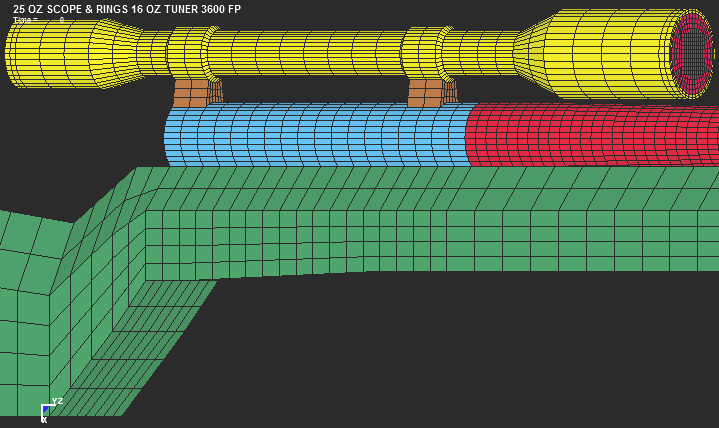
THE 3-D MESH.... This view shows the mesh detail. Only half of the mesh is actually in the calculation. There is a vertical plane of symmetry (X-Z Plane) down the bore axis and the center of the stock. The mesh is reflected across this plane for the for this 3-D mesh picture. The boundary condition for the calculation forced all nodes on the symmetry plane to remain on the plane, but the nodes are allowed to move but constrained to remain on the plane. For the 3-D model without a tuner, there are 16,053 nodes and 11,428 elements. For the model with the tuner, there are 16,913 nodes and 12,004 elements. Every microseconds of pressure vs time data, the conditions of the model were stored for post-processing.
Full Rifle Model Weights and CG Locations
| Item | No Tuner Weight (lb) |
Tuner 8 oz (lb) |
Tuner 16 oz (lb) |
| Barrel | 6.42 | 6.42 | 6.42 |
| Action | 2.00 | 2.00 | 2.00 |
| Stock | 3.00 | 3.00 | 3.00 |
| Scope | 1.56 | 1.56 | 1.56 |
| Tuner | 0 | 0.5 | 1.0 |
| Total | 12.98 | 13.48 | 13.98 |
| (in) | (in) | (in) | |
| X - CG Below Bore |
0.4344 | 0.4183 | 0.4028 |
| Z - CG Forward of Bolt Face |
1.8359 | 2.5800 | 3.2694 |
| CONCLUSION.... Maybe the "consensus" was that a rifle barrel vibrated in one or more of the mode shapes when fired. That was because the mode shapes and frequencies were easy to calculate and they did seem to answer some of the questions. From these FEA dynamic pressure calculations, it appears that the recoil and forced deformations are much more important than the natural vibration modes in determining where a barrel is pointing when the bullet exits the muzzle. Then after the bullet exits the muzzle, the rifle barrel vibrates in its various natural frequencies and mode shapes. Put another way, consider a guitar string being plucked. One pulls the string into a position (forced position) then releases it and the string vibrates at is natural frequency. The recoil and bullet motions "pulls" the rifle barrel to a new shape and once the bullet leaves the barrel, then the barrel vibrates. However, the addition of the scope to the model has shown some small high frequency vibrations superimposed on the forced deformations, both of which, slightly alter where the muzzle points before the bullet exits. For lowering the amplitude of the high frequency vibrations, it appears that even an "out of tune" tuner is better than no tuner at all. |

LIGHT RIFLE BARREL ANALYSIS.... There is more info on a Light Rifle here:
Light Rifle Page.

FLUTED BARREL ANALYSIS.... There is more info on Fluted Barrels here: Fluted
Barrel Page.
![]()
Full Rifle - Dynamic Response During Firing

MOVIE: NO TUNER.... This movie clip shows the powder's gas pressure
traveling up the barrel. The deformations have been amplified by 1000X so one
can see the motions more clearly. If the deformations were not amplified the
movie would show no motion and only the stress color fringes. These movies were
calculated with an earlier pressure curve that delivered a 3424 muzzle velocity.
Also gravity was not present since the barrel's downward sag would obscure
viewing the barrel motions.

MOVIE: NO TUNER.... This movie clip is the same as above, but the
deformations are not amplified and are shown full scale at 1X. The scope's
objective doesn't really hit the barrel and the rifle doesn't really recoil off
the bench!
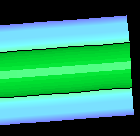
MUZZLE AT EXIT.... This picture shows the orientation of the muzzle at
the time of bullet exit, approximately 0.0010482 seconds. It is pointing below
the original bore axis and is rapidly moving downward. The deformations are
amplified by 1000X.
![]()
Full Rifle & 16 oz Tuner - Dynamic Response During Firing

MOVIE: 16 OZ TUNER.... This movie clip shows the powder's gas pressure
traveling up the barrel. The deformations have been amplified by 1000X so one
can see the motions more clearly.
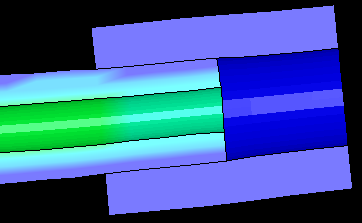
MUZZLE & TUNER AT EXIT.... This picture shows the orientation of the
muzzle at the time of bullet exit, approximately 0.0010482 seconds. It is
pointing upward and stays near this position for about 0.0001 second. See the
chart below. The deformations are amplified by 1000X.
![]()
Five
Shot Groups With/Without A Tuner
 vs
vs 
OBJECTIVE.... The objective of this series of calculations was to determine how the addition of a 16 oz tuner effected the vertical spread of a "typical" five shot group where pressure vs time data were available. The Finite Element Model of the full rifle was used with each pressure vs time curve. Each of the pressure curves was used to generate a separate loading function for the model. Five separate calculations were performed for the model with and without a tuner. These calculations were used to determine where the muzzle of the barrel was pointing projected to a 100 yard target and where the bullet would hit if it were a perfect bullet and there was no aiming error or wind. The projection of the muzzle at bullet exit time is shown on the charts and in the Table 1.
Note: Benchrest shooters take great care in their reloading and produce ammunition that has a much smaller velocity spread than the data used here. That is why I put "typical" in quotes.
MUZZLE SAG DUE TO GRAVITY.... The calculations were performed with a barrel that has a chamber with the dimensions of the 6PPC caliber brass. Gravity caused the end of the muzzle to deflect slightly downward due its own weight and stock deflections. For this particular barrel and stock, the end sag is 0.00243" at the muzzle and when projected to a 100 yard target it is 0.423" below where it would point in zero gravity. With the addition of the 16 oz tuner, the end sag is 0.00359" and projected to a 100 yard target it is 0.751" low.
BULLET AT THE TARGET.... The bullet drop for the five separate muzzle velocities was calculated and added to the muzzle projection to determine where the bullet would actually strike the 100 yard target. For these calculations it was a perfect world. There is no horizontal variation because of the model's vertical plane of symmetry. There is no wind. The bullets are perfect 70 gr Nosler Ballistic Tips. The scope was perfect with a perfect hold for each shot. The only variation was in the five separate pressure curves and the dynamics of the full rifle and barrel with/without a tuner. Table 2 is a tabulation of where the bullet would strike the 100 yard target in this perfect world.
CONCLUSION.... The large variation in pressure curves and the resulting velocity spread of 381 fps would produce a vertical group size of 0.7262 inches with the Finite Element full rifle model. With the same five pressure curves, the addition of a 16 ounce tuner reduces the vertical group size to 0.2419 inches. This is a 67% reduction in vertical group size.
| Larger Groups Without a Tuner: Summary: Higher velocity shots exit early while pointing higher at the target and drop less in reaching the target. Lower velocity shots exit later while pointing lower at the target and drop more in reaching the target. Bad additive combination. |
| Smaller Groups With a Tuner: Summary: Higher velocity shots exit early while pointing lower at the target but drop less in reaching the target. Lower velocity shots exit later while pointing higher at the target but drop move in reaching the target. Counteracting combination. |
Five Separate Pressure vs Time Data
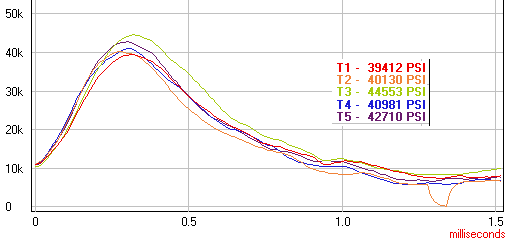
6PPC PRESSURE CURVES.... I received permission form Recreational
Software, Inc to use their 6PPC Pressure vs Time curves. I downloaded the
Free Pressure Trace software in demo mode. Included in the download is the
sample five shot pressure vs time curves for a 6PPC out of a clean cold barrel
shooting the 70 gr Nosler Ballistic Tips (Moly) bullets. I was able to extract
the 249 points of digital data from the file for each of the five curves. I
create 5 separate pressure loading curves for the Finite Element model of the
full rifle. In my calculations, all of the bullets would exit before 1 ms so
data beyond that point was not used.
![]()
Five
Shots 6PPC No Tuner

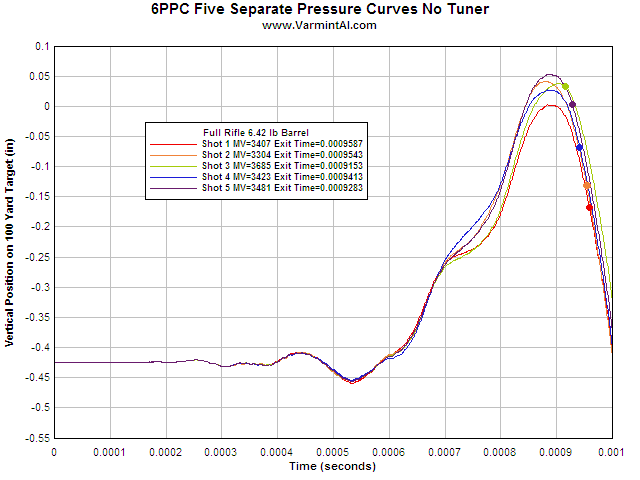
MUZZLE PROJECTION NO TUNER.... The sag due to gravity causes the muzzle
to point 0.354 inches lower than without including gravity. The muzzle
projection is on a rapid downward swing at the bullet exit time for each
shot. The highest velocity shot (Shot 3) exits the barrel at the earliest
time and while the muzzle is pointing at the highest position on the target.
Also this highest velocity shot will have less drop in reaching the target. The
lowest velocity shots (Shot 2 and Shot 3) exits the muzzle at a later time when
the muzzle is pointing lower on the target. The lower velocity shots will also
drop more in reaching the target. This combination leads to larger groups. With
the large variation in muzzle velocity of 381 fps, the vertical spread in
pointing to the 100 yard target is 0.201 inches.
| Summary - Without a Tuner: Higher velocity shots exit early while pointing higher at the target and drop less in reaching the target. Lower velocity shots exit later while pointing lower at the target and drop more in reaching the target. Bad additive combination. |
![]()
Five
Shots 6PPC With 16 oz Tuner

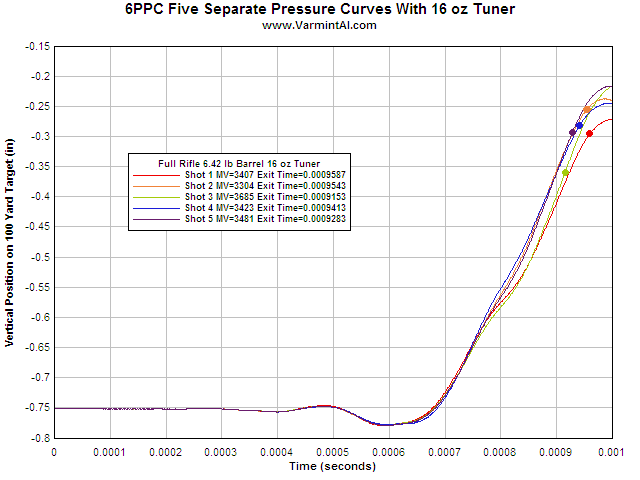
MUZZLE PROJECTION 16 OZ TUNER.... With the 16 oz Tuner the sag due to
gravity causes the muzzle to point 0.670 inches lower than in zero gravity.
Using the same five pressure curves and with a 16 oz tuner, the muzzle
projection is on or near an upward peak at the bullet exit time for each of the
shots even though there is a large variation in muzzle velocity. Unlike the case
with no tuner, the highest velocity shot does not exit with the muzzle pointing
to the highest position on the target. The maximum spread is only 0.104 inches
compared to 0.201 inches for the case with no tuner. That is a 50% reduction in
vertical spread of the muzzle pointing to the 100 yd target.The highest velocity
shot (Shot 3) exits the barrel at the earliest time before the barrel has
reached its highest upward swing on the target. So (Shot 3) is pointing lower on
the target, but it will drop less in reaching the target. The lowest velocity
shot (Shot 2) exits the barrel when the barrel is pointing to a higher point on
the target, but it will drop more in reaching the target.These two conditions
counteract each other and lead to smaller groups. Even with the large variation
in muzzle velocity of 381 fps, the vertical spread in pointing to the 100 yard
target is only 0.104 inches.
| Summary - With a Tuner: Higher velocity shots exit early while pointing lower at the target but drop less in reaching the target. Lower velocity shots exit later while pointing higher at the target but drop move in reaching the target. Counteracting combination. |
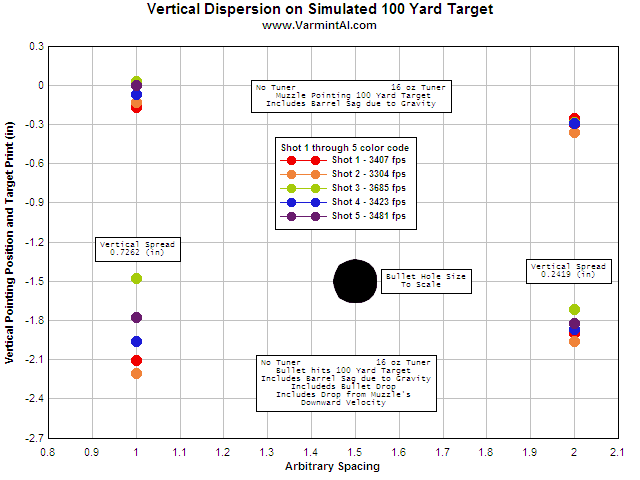
AT THE TARGET.... After all the calculations, here is pictorial summary
and what happens at the 100 yard virtual target. The top "groups" show
where the muzzle is pointing when the bullet exits the barrel. The bottom
"groups" includes the bullet drop getting to the target and drop due
to the muzzles downward velocity. The vertical plane of symmetry in the model
does not allow for horizontal dispersion. The highest and lowest velocity shots
increase the group size, but have less of an effect with the tuner. The bullet
impact points are shown with small colored dots that are not to scale. The
actual size of the bullet holes would have obscured where each bullet would have
hit.
Table 1: Muzzle Projected to a 100 Yard Target
| Shot No. | Muzzle Velocity (fps) |
Bullet Exit Time (seconds) |
POI No Tuner (inch) |
POI 16 oz Tuner (inch) |
| 1 | 3407 | 0.0009587 | -0.1617 | -0.3347 |
| 2 | 3304 | 0.0009543 | -0.1308 | -0.3159 |
| 3 | 3685 | 0.0009153 | +0.0338 | -0.1665 |
| 4 | 3423 | 0.0009413 | -0.0669 | -0.2982 |
| 5 | 3481 | 0.0009283 | +0.0037 | -0.2488 |
| Maximum Spread Muzzle Projection | 0.7262 | 0.2419 | ||
Table 2: Bullet Drop due to the Muzzle's Downward Velocity
at the Time of Bullet Exit
| Shot No. | Muzzle Velocity (fps) |
Bullet Time of Flight (sec) |
No Tuner Muzzle Vertical Velocity (inch/sec) |
16 oz Tuner Muzzle Vertical Velocity (inch/sec) |
No Tuner Downward Velocity Bullet Drop (inch) |
16 oz Tuner Downward Velocity Bullet Drop (inch) |
| 1 | 3407 | 0.093 | -3.917 | -0.333 | -0.364 | -0.031 |
| 2 | 3304 | 0.096 | -4.188 | -0.316 | -0.402 | -0.030 |
| 3 | 3685 | 0.086 | -1.988 | -0.166* | -0.171 | -0.014 |
| 4 | 3423 | 0.092 | -3.624 | -0.298 | -0.335 | -0.028 |
| 5 | 3481 | 0.091 | -3.035 | -0.249 | -0.276 | -0.026 |
* Note: Shot 3 appears to exit when the muzzle is rising. But this is not the case. The plot "6PPC Five Separate Pressure Curves with 16 oz Tuner" shows the point where the muzzle is pointing to at the target is rising, but the the muzzle's end velocity is moving downward at 0.166 in/sec at that time. The bending in the barrel causes the muzzle to be pointing upward while the muzzle itself is actually moving downward.
Table 3: Muzzle Projected to a 100 Yard Target
Plus the Bullet Drop Calculated from the Muzzle Velocity
| Shot No. | Muzzle Velocity (fps) |
Bullet Flight Drop in 100 Yd (inch) |
No Tuner Including Bullet Drop (inch) |
16 oz Tuner Including Bullet Drop (inch) |
| 1 | 3407 | -1.5724 | -2.1038 | -1.8985 |
| 2 | 3304 | -1.6702 | -2.2031 | -1.9543 |
| 3 | 3685 | -1.3397 | -1.4769 | -1.7124 |
| 4 | 3423 | -1.5569 | -1.9590 | -1.8658 |
| 5 | 3481 | -1.5044 | -1.7769 | -1.8234 |
| Maximum Spread Including Bullet Drop | 0.7262 | 0.2419 | ||
ADDING IT ALL TOGETHER.... After including where the muzzle is pointing at the 100 yard target, the bullet drop for each shot's muzzle velocity, and finally the downward velocity of the swing of the muzzle as the bullet exits, the results show that the barrel without a tuner would shoot a 0.7262 inch group and the same five shots with a 16 ounce tuner would shoot a 0.2419 inch group. The 16 ounce tuner gave a 67% reduction in group size.
![]()
Bloop Tube added to the Muzzle

BLOOP TUBE.... The Bloop Tube muzzle tuner has a 1/16" wall aluminum
tube extends 5" past the muzzle. The 1" long steel weight is 7.67
ounces and the aluminum tube weighs 1.58 ounces. The deformations are multiplied
by 1000X.

BLOOP TUBE AT BULLET EXIT.... This view shows the Bloop Tube at the time
that the bullet exits the muzzle.
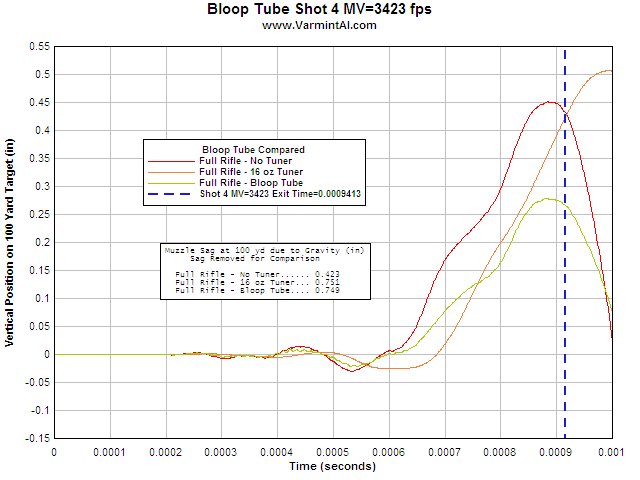
BLOOP TUBE.... This graph shows the muzzle projected to the 100 yard
target for the Bloop Tube with a 3423 fps shot. The flexibility of the aluminum
tube makes the Bloop Tube design less effective than the same weight attached
directly to the muzzle. Two of the previous curves were included for comparison.
![]()
The Pressure vs Time Input Data

6PPC PRESSURE CURVE.... I received permission form Recreational
Software, Inc to use their 6PPC Pressure vs Time curve. It was possible to
extract the digital data from the plot data. I ran the FEA calculations with ese
curves as the driving force on a 70 gr bullet. The muzzle velocity for T4 3423
fps and the bullet exit time was 0.0009413 in the model. It is difficult to
exactly match the real world exit time because the curve starts out at about
11,000 psi at time zero. I had to extrapolate back to a zero pressure time for
the analysis. Therefore, for the calculations the actual bullet exit times are
only approximate and depend on my estimate of the zero time. I painstakingly
digitized the T5 curve by hand before I knew that the Recreational Software was
a free download and when the software is installed it comes with a number of
sample pressure curves that contain the digitized data.
Calculate The Muzzle Velocity and Distance Timing
LOADING CONDITIONS.... I wrote a small BASIC program that uses the 6PPC time vs pressure curve. I used numerical methods to incrementally accelerate a 68 gr 6mm bullet in a 22" barrel. I was able to calculate the velocity as the bullet moves down the barrel and the displacement of the bullet as time proceeds. Here is the basic program 6PPC.BAS. Here is the input file I used for the digitized data TVP.TXT. You are welcome to download them to use and/or modify. I have added comment cards to explain what the program is doing. One spin off of this BASIC program is that one can get an idea of the velocity gain for each additional inch of barrel length. For this particular example the muzzle velocity was 3424 fps and the muzzle exit time was 0.001035 seconds.
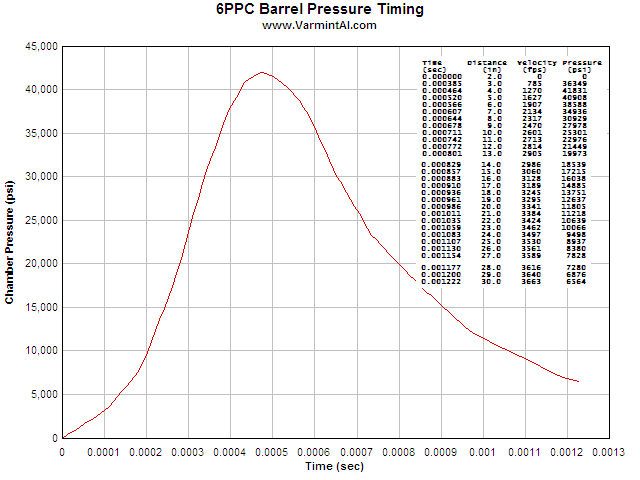
SOURCE OF PRESSURE PLOT.... The pressure trace is a typical pressure vs.
time trace from Recreational
Software, Inc. I hand digitized the T5 line to generate the Pressure vs Time
curve for input to the calculation. Note that the pressure on the source curve
starts at about 12,000 psi at zero time. I extrapolated back to where it looked
like the actual zero point was. For the FEA calculations, the pressure was
applied to the barrel's bore following behind the bullet. The velocity of sound
in 416 stainless steel is 14,900 fps and stress waves have time to
propagate up and back the full length of the barrel more than four times after
ignition and while the bullet is traveling within the barrel. The muzzle end of
the barrel has ample time to "know" that something is going on at the
breach end before the bullet exits. I added a table of the calculated conditions
at each inch of bullet travel down the barrel.
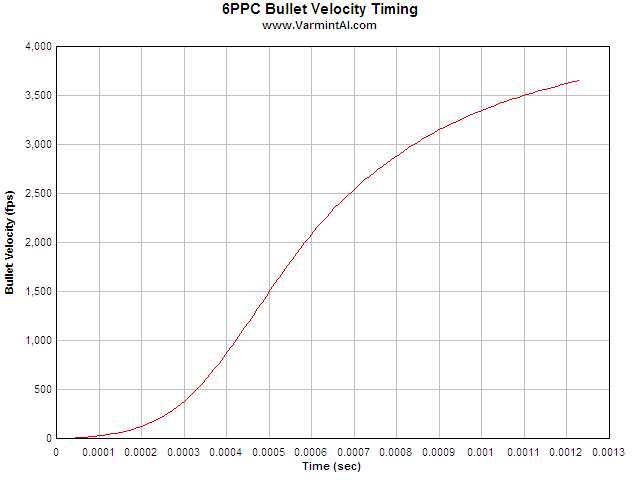
CALCULATED VELOCITY.... This curve shows the instantaneous velocity of
the bullet as a function of time.
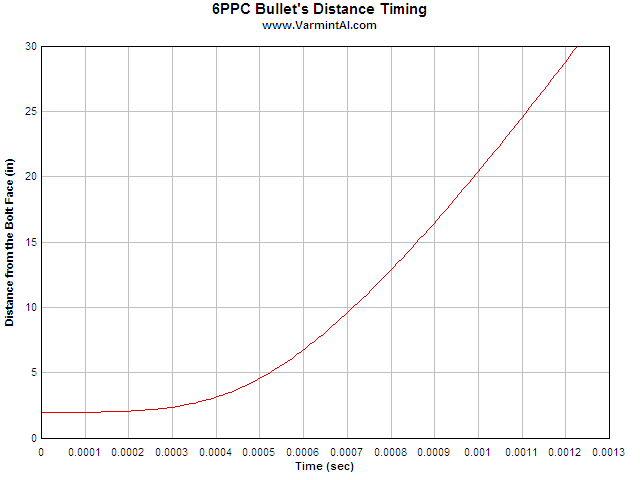
CALCULATED DISTANCE.... This curve shows the distance the bullet has
traveled down the barrel vs time. Note that the bullet starts out two inches
from the bolt face or barrel breach at time zero.
INPUT DATA FOR THE ANALYSIS.... Notice that the bullet starts out 2" from the bolt face. The bullet's base would exit a 22" barrel in approximately 0.0010482 seconds, but I continued the curve out to 0.00122 seconds because I had data for that length of time. One interesting feature of these curves are that one can get an idea of how much velocity is gained in a barrel for increased lengths. The most time consuming procedure in the FEA calculation was setting up the pressure loading data and having it arrive at the correct time and value down the length of the barrel. The muzzle velocity this data is 3423 fps in a 22 inch barrel.
Good Hunting... from Varmint Al![]()
For the serious reader: How to
Check Another Engineer's Calculation.![]()
Last Updated: 02/08/2013
End of Page![]()